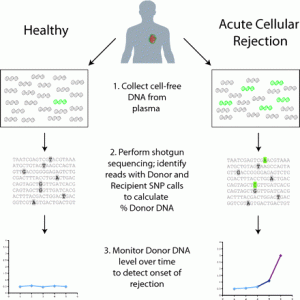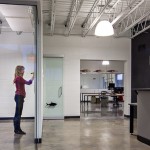I remember in grad school I had a professor who used to say something to the effect of, “behold, the awesome power of yeast genetics.” Of course his lab used yeast in a lot of their studies, but he was also right. It really is Awesome. I think you can probably say the same thing for scientists using Next-gen sequencing to unlock the questions they are most interested in. The number of applications and tools that have come out of “just sequencing DNA” over the last decade are immense. I admit that while I find the chemistry and technology of DNA sequencing to be interesting, I’m more fascinated with the questions you can address as a molecular biologist using sequencing technologies. A good example is the recent use of cell-free and circulating free DNA (cfDNA) as an assay for monitoring rejection of donor transplanted organs.
The advantage and promise of this application is that it is noninvasive and potentially just as accurate and sensitive for monitoring organ transplants. Currently, the gold standard for monitoring transplant organs is a biopsy to assess the transplant status. This approach however is not free from complication, expense, and potential discomfort to the recipient. Since donor genomes are distinct from the recipient’s genome, it is possible to monitor the donated organ health by collecting plasma from a blood draw, isolating DNA to identify recipient and donor genomes to assess health of the transplanted organ. (see fig 1 below)
At Cofactor, we perform cfDNA assays, and the implications of this technology also hit home for me on a personal level. Back in December of last year, I donated one of my kidneys to my best friend that I grew up next door to and have known since we were 4 and 5 years old. You can find out more about our story here. The good news is the surgery was successful for my friend and me. We are both recovering well and my friend is currently at low risk of rejection.
I have no doubt that this type of test to monitor transplants will only continue to be refined and verified as an important clinical measurement for patients receiving an organ transplant. With that said, you knew it was coming: “Behold, the awesome power of Next-gen sequencing”.
You can find out more about how this application is being used and about being a living donor in the links below.
For more information from the literature:
Universal noninvasive detection of solid organ transplant rejection. Thomas M. Snyder et al. Proc Natl Acad Sci U S A. 2011 Apr 12;108(15):6229-34.
Circulating cell-free DNA enables noninvasive diagnosis of heart transplant rejection. De Vlaminck et al. Sci Transl Med. 2014 Jun 18;6(241)
https://www.genome.gov/27558511
For more information about being an organ donor:
https://www.americantransplantfoundation.org/
https://www.mayoclinic.org/departments-centers/transplant-center/kidney-transplant




